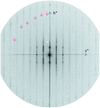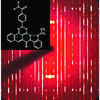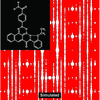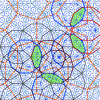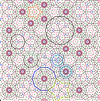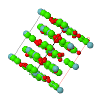issue contents
April 2014 issue

Cover illustration: A trajectory plot showing the gradient vector field of electron density through the pyridine ring of the isoniazid molecule. Gradient trajectories originate at the atomic centres and terminate at the bond critical points. The thick solid lines represent the boundaries of the atomic basins. See Fig. 7 in Rajalakshmi et al. [(2014), Acta Cryst. B70, 331-341].
research papers
Download citation


Download citation


The electron density of 2-methyl-1,3-cyclopentanedione was refined versus synchrotron ultra-high-resolution data using a multipolar model and a virtual and real spherical atoms model. The electrostatic properties were analyzed.
CCDC reference: 972265
Download citation


Download citation


The derivative from the hexagonal close packing LiZn4 − x (x = 0.825) binary compound crystallizes in the orthorhombic superspace group Cmcm(α00)0s0.
B-IncStrDB reference: 8692EytSde
CCDC reference: 971019
Download citation


Download citation


Diffraction studies of K9H7(SO4)8·H2O crystals were performed using synchrotron radiation in the temperature range 293–450 K in order to reveal the structural conditionality for anomalies in physical properties.
The influence of reaction time on the CaCO3 microparticle growth in the presence of a conjugate drug–copolymer has been studied. The sorption capacity of composite materials is influenced by the ratio between polymorphs, and increased with the increase of calcite content and ageing time.
Download citation


Download citation


The gradual transition from orthorhombic to tetragonal space group of Al+3-doped (Y,Ca)Ba2Cu3O7−y (YBCO) whiskers has been studied, focusing on the relationships between structural aspects and the physical properties of these materials.
Download citation


Download citation


Open  access
access
 access
accessA unified superspace model, based on average triplite structure, for the description of different modulation periodicities of wagnerite and related phases
A computational study to assess the performance of dispersion-corrected plane-wave density functional theory to simulate reliable structural information for molecular crystal structures dominated by hydrogen bonding and dispersion interactions is reported.
A monoclinic superstructure occurring in a Ce10W22O81 compound was identified by transmission electron microscopy. The partial oxidation of Ce3+ along with interstitial oxygen ions could explain this superstructure.
Download citation


Download citation


Open  access
access
 access
accessThe structure of the title compound has been refined by single-crystal synchrotron X-ray diffraction combined with spherical-aberration-corrected scanning transmission electron microscopy. The structure consists of iron-centred normal and disordered Zn12 icosahedra, zinc-centred Zn12 icosahedra, zinc-centred Zn16 icosioctahedra, and dangling Zn atoms that do not constitute any polyhedra.
CCDC reference: 978356
Download citation


Download citation


Single-crystal X-ray diffraction of the β-phase of Pigment Red 170 reveals lines of strong diffuse scattering indicating severe layer stacking disorder. An attempt to deduce an average structure resulted in two plausible solutions, thus challenging the concept of an average structure for this material.
Possible stacking sequences of this organic layer structure were derived by order–disorder theory. Lattice-energy minimizations revealed local structures and stacking probabilities, and explained the disorder and the diffuse scattering observed by X-ray single-crystal, powder and electron diffraction.
Download citation


Download citation


This article discusses the structural variation of decagonal Al–Cu–Rh as a function of temperature.
Download citation


Download citation


The results of the first quantitative structure analysis of the Frank–Kasper decagonal Zn–Mg–Dy phase based on single-crystal X-ray diffraction data taken at different temperatures are reported.
CCDC reference: 981708
Download citation


Download citation


The charge-density analysis of isoniazid reveals the electron-density distribution and its electrostatic properties. The topological study on hydrogen bonding shows the strength of intermolecular interactions.
CCDC reference: 929008
Download citation


Download citation


This article is focused on the structure determination of three anhydrous xylazine hydrochloride forms by powder X-ray diffraction without X-ray monochromatization. The physical properties of the determined structures were analysed.
Download citation


Download citation


A method was developed and implemented for fitting a crystal structure to a powder pattern, even if the lattice parameters deviate strongly. The method is even successful for powder diagrams of very low quality. Applications include an automatic fit starting from predicted structures or isostructural compounds.
Download citation


Download citation


Crystal structures of KLaS2, KPrS2, KEuS2, KGdS2, KLuS2, KYS2 and RbYS2, which belong to the α-NaFeO2 structural family ( ), have been determined as well as NaLaS2, which is derived from the disordered NaCl structural type (
), have been determined as well as NaLaS2, which is derived from the disordered NaCl structural type ( ). The article is accompanied by a crystal-chemical analysis of group 1 and thallium(I) rare-earth sulfides as well as by a table that critically considers the published data of this class of compounds.
). The article is accompanied by a crystal-chemical analysis of group 1 and thallium(I) rare-earth sulfides as well as by a table that critically considers the published data of this class of compounds.
Some of the t(x) functions (t = a, b, c) in the systems BiSX1 − xYx (X, Y = Cl, Br, I) exhibit strong deviations from linearity.
Download citation


Download citation


The series of structures reported in this work illustrate the inherent unpredictability in the crystalline products of even closely related molecules. The main similarities in packing arrangements in the structures can be attributed to the formation of common intermolecular interactions.
Download citation


Download citation


Cu/Zn disorder in Cu2ZnSnS4 has been investigated by the X-ray resonant single-crystal diffraction technique.
CCDC reference: 986377
short communications
Download citation


Download citation


The recently proposed crystal structure model of decafluorocyclohex-1-ene at 4.2 K is completed by an additional alternative molecular orientation. The structure is refined by the derivative difference method in the rigid-body approximation leading to perfect agreement between observed and calculated neutron powder patterns.
CCDC reference: 971462


 journal menu
journal menu


















